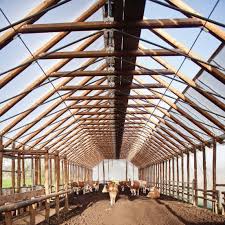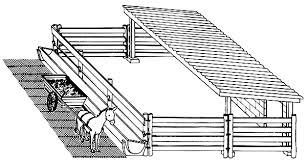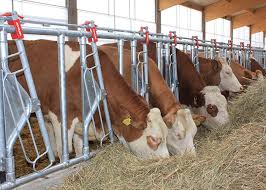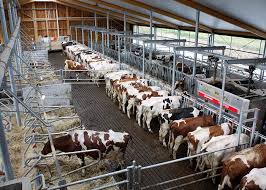Cattle housing is a crucial aspect of cattle farming that directly influences the health, productivity, and welfare of the animals. Providing proper housing and facilities for cattle is essential not only for their comfort but also for maximizing milk production and growth rates.
Cattle are large animals that require adequate space, ventilation, and protection from extreme weather conditions. A well-designed housing system can minimize stress, prevent disease, and enhance overall productivity.
The type of housing needed may vary based on several factors, including the climate, herd size, farming practices, and specific needs of the cattle. In colder climates, insulated barns may be necessary to keep cattle warm during harsh winters. In contrast, warmer regions may benefit from open-sided barns that allow for better airflow and cooling. Regardless of the type of housing chosen, several key elements must be considered to ensure the facilities meet the animals’ needs.
Effective cattle housing incorporates aspects such as design, space allocation, flooring, and bedding materials. The layout should allow for easy movement and access to feed and water, as well as provide separate areas for resting, feeding, and milking.
This segregation helps reduce competition and aggression among the cattle, promoting a more peaceful environment. Adequate space is also essential; each animal requires sufficient room to lie down, stand up, and move freely without feeling confined. Overcrowding can lead to stress, which negatively impacts cattle health and productivity.
Ventilation is another critical factor in cattle housing. Proper airflow helps regulate temperature and humidity levels, reducing the risk of respiratory diseases. Stale air can harbor pathogens, so ensuring a steady exchange of fresh air is vital. Additionally, windows or vents can provide natural light, which can further enhance the living environment for the cattle.
Bedding materials play a significant role in cattle comfort and hygiene. Soft, dry bedding can help prevent injuries and keep cattle warm. Common bedding options include straw, wood shavings, and sand. Each material has its pros and cons regarding comfort, absorbency, and cost. Regular maintenance and cleaning of bedding areas are also necessary to minimize the risk of disease and maintain a healthy environment.
Water access and quality are paramount in cattle facilities. Cattle require a significant amount of fresh water daily, and providing easy access to clean water sources is essential for their health and productivity. Automatic waterers or troughs can help ensure a consistent supply of water, but these systems must be monitored regularly to prevent contamination.
Additionally, the overall management of cattle housing and facilities encompasses sanitation practices, nutrition, and animal welfare considerations. Regular inspections of the facilities are essential to identify and rectify any issues, such as leaks, structural damage, or unsanitary conditions. Moreover, ensuring that cattle receive proper nutrition and veterinary care within the housing system is integral to their health and productivity.
Types of Cattle Housing

There are several types of cattle housing, each designed to meet the specific needs of the animals. Here are some common options:
1. Loose Housing: This system allows cattle to move freely within a barn or shelter. Loose housing provides comfort and space for social interaction, reducing stress among animals.
2. Tie-Stall Barns: In tie-stall barns, individual stalls are provided for each animal. This system allows for easier feeding and milking but may restrict movement, which can affect animal welfare.
3. Free-Stall Barns: Free-stall barns offer individual resting areas with the freedom for cattle to move around. This design promotes comfort and reduces competition for space, leading to better overall health.
4. Pasture-Based Systems: Cattle are kept primarily in pastures, with minimal shelter provided. This system promotes natural behavior and allows for grazing but requires effective management to protect animals from harsh weather conditions.
5. Calf Hutches: Individual hutches are used for housing calves. These small, well-ventilated structures provide protection from the elements while allowing for proper monitoring of health and growth.
6. Beef Cattle Feedlots: Feedlots are designed for fattening beef cattle before slaughter. These facilities focus on maximizing feed efficiency and minimizing space, often using outdoor pens or barn systems.
Site Selection for Cattle Facilities
Choosing the right site for cattle housing is essential for animal welfare and operational efficiency. Key factors to consider include:
1. Topography: Select a site with good drainage to prevent water accumulation and muddy conditions. Hillsides can help with natural drainage, reducing the risk of flooding.
2. Access to Resources: Ensure the site has easy access to water sources, feed storage, and veterinary services. Proximity to these resources can improve management efficiency.
3. Environmental Factors: Consider local climate conditions when selecting a site. Factors like wind direction, sun exposure, and temperature can impact cattle health and comfort.
4. Proximity to Neighbors: Maintain a reasonable distance from neighboring farms and residential areas to minimize potential conflicts related to noise, odors, or other factors.
5. Zoning Regulations: Check local zoning laws and regulations to ensure compliance with any restrictions on livestock housing and operations.
6. Biosecurity Measures: Choose a site that allows for effective biosecurity measures to prevent the introduction of diseases. This includes controlling access to the facility and ensuring proper sanitation practices.
Read Also: Apple Maggot: Description, Damages Caused, Control and Preventive Measures
Design Considerations for Cattle Housing

When designing cattle housing, several considerations should be kept in mind to ensure optimal animal welfare and efficiency:
1. Space Requirements: Provide adequate space per animal based on its size and type. This includes resting areas, feeding space, and room for movement to reduce stress and injury.
2. Ventilation: Ensure proper ventilation to maintain air quality and control humidity levels. Good airflow helps reduce respiratory issues and improves overall animal health.
3. Temperature Control: Design housing to provide shade in hot weather and insulation in cold weather. Proper temperature control helps reduce stress and maintain comfort.
4. Flooring Materials: Choose flooring materials that provide good traction and are easy to clean. Non-slip surfaces can reduce the risk of injuries, while durable materials can withstand wear and tear.
5. Feeding and Watering Systems: Incorporate efficient feeding and watering systems to ensure animals have constant access to food and clean water. Automated systems can reduce labor and improve efficiency.
6. Safety Features: Include safety features such as proper fencing, secure gates, and protective barriers to prevent accidents and ensure animal security.
Ventilation and Air Quality Management
Proper ventilation is critical in cattle housing to maintain good air quality and prevent respiratory issues. Here are key points regarding ventilation management:
1. Importance of Ventilation: Effective ventilation helps remove stale air, excess heat, moisture, and harmful gases, ensuring a healthy environment for cattle.
2. Natural Ventilation: Use design features like roof vents, sidewall openings, and overhangs to facilitate natural airflow. This method is energy-efficient and can maintain a comfortable temperature.
3. Mechanical Ventilation: In areas with extreme weather conditions, mechanical ventilation systems (fans and exhaust systems) may be necessary to control air quality and temperature effectively.
4. Monitoring Air Quality: Regularly monitor air quality parameters such as temperature, humidity, and ammonia levels. This ensures that conditions remain optimal for cattle health.
Flooring Options and Maintenance
Choosing the right flooring for cattle housing is essential for animal welfare and ease of maintenance. Here are some flooring options and their considerations:
1. Concrete Floors: Durable and easy to clean, concrete floors can provide good traction with the right surface texture. However, they can be hard on cattle’s feet, so rubber mats may be added for comfort.
2. Dirt or Sand Floors: These natural surfaces can provide cushioning and are easier on animals’ joints. However, they require regular maintenance to prevent mud accumulation and should be managed for hygiene.
3. Rubber Matting: Rubber mats can improve comfort and reduce slipping. They are easy to clean and can be placed over concrete floors to enhance animal welfare.
4. Maintenance: Regularly inspect flooring for wear and damage. Clean surfaces frequently to prevent the buildup of manure and moisture, which can lead to health issues.
Water Supply and Management
Access to clean water is essential for cattle health and productivity. Here are key considerations for water supply and management:
1. Adequate Water Supply: Ensure a constant supply of fresh, clean water. Cattle require significant amounts of water daily, especially during hot weather or lactation.
2. Watering Systems: Use automated watering systems (such as troughs or nipples) to ensure that cattle have access to water at all times. These systems can reduce labor and improve efficiency.
3. Water Quality Monitoring: Regularly test water sources for contaminants, such as bacteria and chemical residues. Clean water promotes better health and reduces the risk of disease.
4. Maintenance: Clean water troughs and tanks regularly to prevent algae growth and contamination. Ensure that the watering system is functioning correctly and is not frozen during cold weather.
Read Alos: Worm Infestation on Ruminant Animals: Symptoms and Treatment
Feeding and Nutrition Facilities

Providing proper feeding and nutrition facilities is essential for the health and productivity of cattle. Here are some key aspects to consider:
1. Feeding Systems: Use efficient feeding systems, such as bunk feeders or silage bags, to deliver feed. Automated feeding systems can help manage feed distribution and reduce waste.
2. Nutritional Needs: Understand the nutritional requirements of cattle based on their age, weight, and production stage. Consult with a nutritionist to formulate balanced rations.
3. Storage Facilities: Store feed in clean, dry conditions to prevent spoilage and contamination. Use bins or silos designed to protect feed from pests and moisture.
4. Monitoring Feed Intake: Regularly monitor feed intake to ensure cattle are consuming the proper amounts. Adjust feeding strategies based on observations of cattle health and weight gain.
Health and Biosecurity Measures
Implementing robust health and biosecurity measures is critical for preventing disease outbreaks and maintaining a healthy herd. Here are key points to consider:
1. Biosecurity Protocols: Establish protocols to minimize the risk of disease introduction. This includes controlling access to facilities, requiring visitors to wear clean clothing and boots, and sanitizing equipment and vehicles.
2. Regular Health Monitoring: Conduct regular health checks on cattle to identify signs of illness early. Monitoring vital signs, such as temperature and behavior, can help detect issues before they become serious.
3. Vaccination Programs: Implement vaccination programs based on veterinary recommendations to protect cattle from common diseases. Keeping accurate vaccination records is essential for tracking and compliance.
4. Isolation of Sick Animals: Designate specific areas for isolating sick or injured animals to prevent the spread of disease. Ensure that these areas are easily accessible but separate from the main herd.
Waste Management Strategies
Effective waste management is vital for maintaining a clean and healthy environment in cattle housing. Here are some strategies to consider:
1. Manure Management: Implement a regular schedule for manure removal to prevent buildup and reduce odors. Manure can be composted or used as fertilizer, benefiting soil health.
2. Waste Storage Facilities: Use appropriate storage facilities, such as manure pits or lagoons, to manage waste safely. Ensure that these facilities are designed to prevent leaching and contamination of water sources.
3. Nutrient Management Plans: Develop a nutrient management plan to utilize manure as a resource while minimizing environmental impact. This includes testing manure for nutrient content and applying it based on crop needs.
4. Environmental Regulations Compliance: Stay informed about local regulations regarding waste management and ensure compliance to avoid penalties and protect the environment.
Safety and Comfort in Cattle Housing
Creating a safe and comfortable environment for cattle enhances their welfare and productivity. Here are essential considerations:
1. Structural Integrity: Ensure that all housing structures are well-built and maintained to prevent accidents. Regular inspections should be conducted to identify and repair any damages.
2. Comfort Features: Provide adequate bedding, such as straw or wood shavings, to promote comfort and reduce stress on cattle. Comfortable resting areas improve overall well-being.
3. Temperature Control: Maintain appropriate temperatures in cattle housing. Use ventilation systems, fans, or insulation to manage heat in summer and warmth in winter.
4. Safe Handling Practices: Train staff on safe handling practices to minimize stress and injury during routine management tasks, such as feeding, milking, and veterinary checks.
Do you have any questions, suggestions, or contributions? If so, please feel free to use the comment box below to share your thoughts. We also encourage you to kindly share this information with others who might benefit from it. Since we can’t reach everyone at once, we truly appreciate your help in spreading the word. Thank you so much for your support and for sharing!
Read Also: Top 10 Vegetable Crops to Grow in Your Backyard






